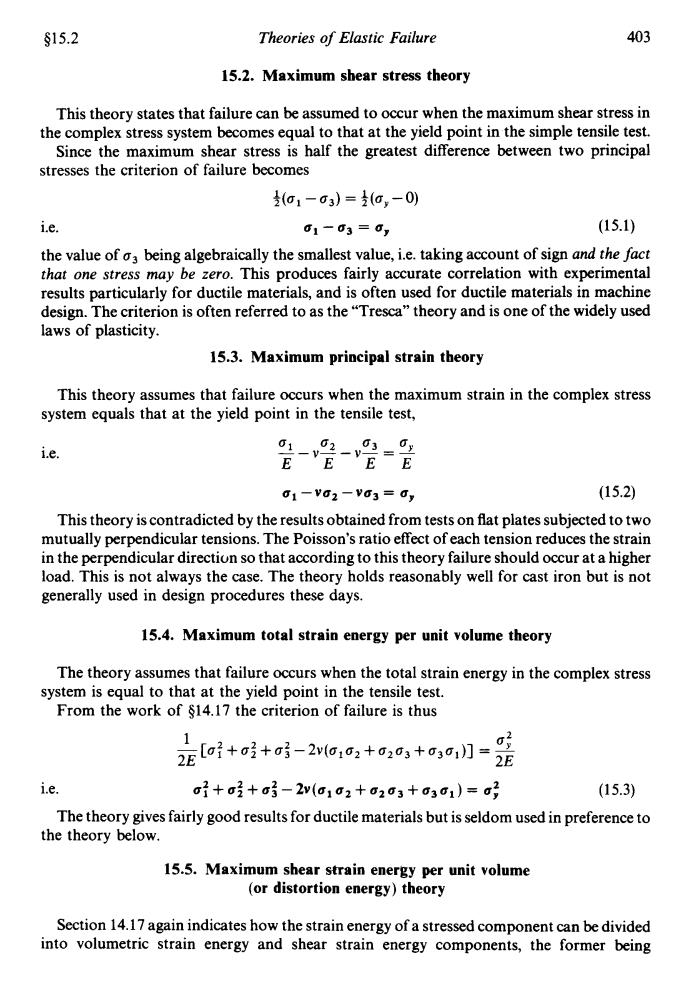正在加载图片...

s15.2 Theories of Elastic Failure 403 15.2.Maximum shear stress theory This theory states that failure can be assumed to occur when the maximum shear stress in the complex stress system becomes equal to that at the yield point in the simple tensile test. Since the maximum shear stress is half the greatest difference between two principal stresses the criterion of failure becomes (a1-03)=(a,-0) 1.e. 0103=0y (15.1) the value of o3 being algebraically the smallest value,i.e.taking account of sign and the fact that one stress may be zero.This produces fairly accurate correlation with experimental results particularly for ductile materials,and is often used for ductile materials in machine design.The criterion is often referred to as the"Tresca"theory and is one of the widely used laws of plasticity. 15.3.Maximum principal strain theory This theory assumes that failure occurs when the maximum strain in the complex stress system equals that at the yield point in the tensile test, i.e. 01-V02-V03=0y (15.2) This theory is contradicted by the results obtained from tests on flat plates subjected to two mutually perpendicular tensions.The Poisson's ratio effect of each tension reduces the strain in the perpendicular direction so that according to this theory failure should occur at a higher load.This is not always the case.The theory holds reasonably well for cast iron but is not generally used in design procedures these days. 15.4.Maximum total strain energy per unit volume theory The theory assumes that failure occurs when the total strain energy in the complex stress system is equal to that at the yield point in the tensile test. From the work of $14.17 the criterion of failure is thus 2E[o子+i+i-2vo102+a203+031】= 2E i.e. +3+-2w(o102+0203+03c1)= (15.3) The theory gives fairly good results for ductile materials but is seldom used in preference to the theory below. 15.5.Maximum shear strain energy per unit volume (or distortion energy)theory Section 14.17 again indicates how the strain energy of a stressed component can be divided into volumetric strain energy and shear strain energy components,the former being$15.2 Theories of Elastic Failure 403 15.2. Maximum shear stress theory This theory states that failure can be assumed to occur when the maximum shear stress in the complex stress system becomes equal to that at the yield point in the simple tensile test. Since the maximum shear stress is half the greatest difference between two principal stresses the criterion of failure becomes i.e. (15.1) the value of a3 being algebraically the smallest value, i.e. taking account of sign and the fact that one stress may be zero. This produces fairly accurate correlation with experimental results particularly for ductile materials, and is often used for ductile materials in machine design. The criterion is often referred to as the “Tresca” theory and is one of the widely used laws of plasticity. 15.3. Maximum principal strain theory This theory assumes that failure occurs when the maximum strain in the complex stress system equals that at the yield point in the tensile test, i.e. a1 --a2 -va3 = ap This theory is contradicted by the results obtained from tests on flat plates subjected to two mutually perpendicular tensions. The Poisson’s ratio effect of each tension reduces the strain in the perpendicular direction so that according to this theory failure should occur at a higher load. This is not always the case. The theory holds reasonably well for cast iron but is not generally used in design procedures these days. (15.2) 15.4. Maximum total strain energy per unit volume theory The theory assumes that failure occurs when the total strain energy in the complex stress system is equal to that at the yield point in the tensile test. From the work of $14.17 the criterion of failure is thus - 1 0: [a: + a: + a: - 2v(a,a, + a2a3 + a3a1)] = - 2E 2E i.e. uf + af +a: - 2v(a1 a2 + aza3 + 03~1) = a: (15.3) The theory gives fairly good results for ductile materials but is seldom used in preference to the theory below. 15.5. Maximum shear strain energy per unit volume (or distortion energy) theory Section 14.17 again indicates how the strain energy of a stressed component can be divided into volumetric strain energy and shear strain energy components, the former being